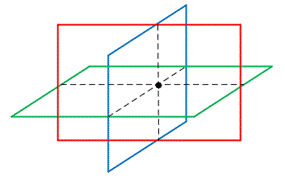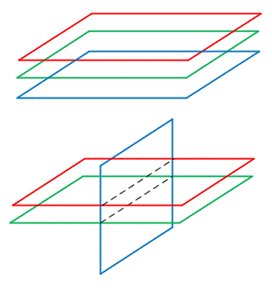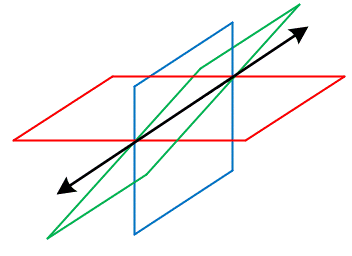
a.
To determine: The geometrically how such a system can have a unique solution.
If the three planes intersect at a single point then, exist a unique solution.
Given Information:
Assume that the graph of a linear equation in three variables is a plane in 3-dimensional space.
Explanation:
Consider the given matrix,
Each linear equation in three variables represent a plane in a 3-dimensional space. There is a unique solution if the three planes intersect at a single point as shown:

Each linear equation in three variables represent a plane.
Thus, if the three planes intersect at a single point then, exist a unique solution.
b.
To determine: The geometrically how such a system can be have no solution and describe several possibilities.
There are no solutions if at least 2 planes are parallel.
Given Information:
Assume that the graph of a linear equation in three variables is a plane in 3-dimensional space.
Explanation:
Consider the given information,
Each linear equation in three variables represent a plane in a 3-dimensional space. There are no solutions if at least 2 planes are parallel. Two such cases are shown:

Each linear equation in three variables represent a plane in a 3-dimensional space. There are no solutions if at least 2 planes are parallel. Two such cases are shown:
Each linear equation in three variables represent a plane. There are no solutions if at least 2 planes are parallel.
c.
To determine: The geometrically how such a system can have infinitely many solution and describe several possibilities also make physical models of you find that helpful.
If the planes intersect at a line or if they are the same plane, to name two ways.
Given Information:
Assume that the graph of a linear equation in three variables is a plane in 3-dimensional space.
Explanation:
Consider the given information,
Each linear equation in three variables represent a plane in a 3-dimensional space. There are infinitely many solutions if the planes intersect at a line or if they are the same plane, to name two ways. These first case is shown below:

Each linear equation in three variables represent a plane in a 3-dimensional space.
There are infinitely many solutions if the planes intersect at a line or if they are the same plane, to name two ways.
Chapter 7 Solutions
PRECALCULUS:GRAPHICAL,...-NASTA ED.
- please question 9arrow_forwardUse the definite integral to find the area between the x-axis and f(x) over the indicated interval. Check first to see if the graph crosses the x-axis in the given interval. 3. f(x) = 4x; [-5,3]arrow_forwardUse the definite integral to find the area between the x-axis and f(x) over the indicated interval. Check first to see if the graph crosses the x-axis in the given interval. f(x)=3e-4; [3,3]arrow_forward
- A small company of science writers found that its rate of profit (in thousands of dollars) after t years of operation is given by P'(t) = (7t + 14) (t² + 4t+7) * (a) Find the total profit in the first four years. (b) Find the profit in the sixth year of operation. (c) What is happening to the annual profit over the long run?arrow_forwardCalculus III May I have an expert explained how the terms were simplified into 6(3-x)^2? Thank you,arrow_forwardCalculus III May I have an expert explain how the integrand was simplified into the final for form to be integrated with respect to x? Thank you,arrow_forward
- Calculus lll May I please have the semicolon statement in the box defined with explanation? Thank you,arrow_forwardCalculus lll May I please have the solutions for the following blank lines? Thank you,arrow_forwardCalculus lll May I please have the solution for the following example? Thank you,arrow_forward
- Calculus lll May I please have numbers 1 and 2 explanations resolved? Thank you,arrow_forward5:38 Video Message instructor Submit Question ||| Darrow_forward8:38 *** TEMU TEMU -3 -2 7 B 2 1 & 5G. 61% 1 2 -1 Based on the graph above, determine the amplitude, period, midline, and equation of the function. Use f(x) as the output. Amplitude: 2 Period: 2 Midline: 2 ☑ syntax error: this is not an equation. Function: f(x) = −2 cos(πx + 2.5π) +2× Question Help: Worked Example 1 ☑ Message instructor Submit Question ||| <arrow_forward
 Calculus: Early TranscendentalsCalculusISBN:9781285741550Author:James StewartPublisher:Cengage Learning
Calculus: Early TranscendentalsCalculusISBN:9781285741550Author:James StewartPublisher:Cengage Learning Thomas' Calculus (14th Edition)CalculusISBN:9780134438986Author:Joel R. Hass, Christopher E. Heil, Maurice D. WeirPublisher:PEARSON
Thomas' Calculus (14th Edition)CalculusISBN:9780134438986Author:Joel R. Hass, Christopher E. Heil, Maurice D. WeirPublisher:PEARSON Calculus: Early Transcendentals (3rd Edition)CalculusISBN:9780134763644Author:William L. Briggs, Lyle Cochran, Bernard Gillett, Eric SchulzPublisher:PEARSON
Calculus: Early Transcendentals (3rd Edition)CalculusISBN:9780134763644Author:William L. Briggs, Lyle Cochran, Bernard Gillett, Eric SchulzPublisher:PEARSON Calculus: Early TranscendentalsCalculusISBN:9781319050740Author:Jon Rogawski, Colin Adams, Robert FranzosaPublisher:W. H. Freeman
Calculus: Early TranscendentalsCalculusISBN:9781319050740Author:Jon Rogawski, Colin Adams, Robert FranzosaPublisher:W. H. Freeman
 Calculus: Early Transcendental FunctionsCalculusISBN:9781337552516Author:Ron Larson, Bruce H. EdwardsPublisher:Cengage Learning
Calculus: Early Transcendental FunctionsCalculusISBN:9781337552516Author:Ron Larson, Bruce H. EdwardsPublisher:Cengage Learning





